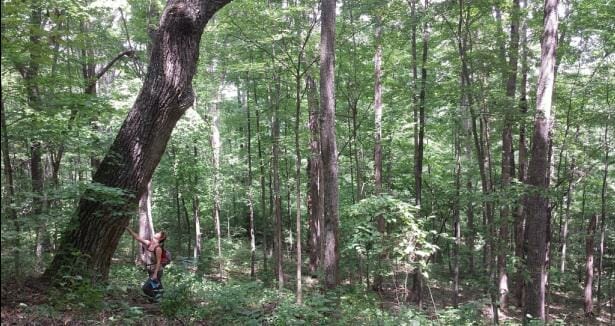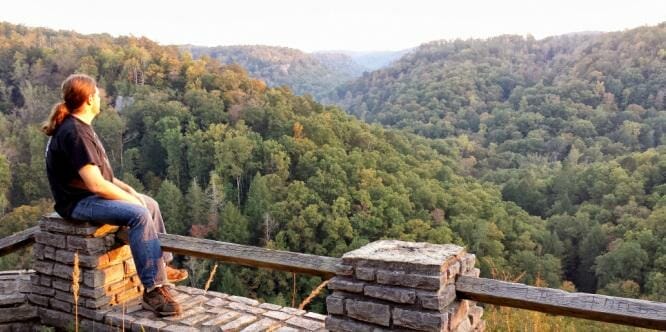Greenwood project approved by Forest Service

By Jim Scheff, Director, Kentucky Heartwood
In the end, the Forest Service did agree to some small changes, and made overtures toward more careful planning in the future. While the Forest Service did not agree to go back and actually survey the project area for rare species and communities, they stated that they planned to receive increased training from the Kentucky State Nature Preserves Commission (KSNPC) on how to identify rare communities, would look for rare communities during project implementation, and adjust management accordingly. They also committed to consulting with KSNPC and Kentucky Heartwood in taking a closer look at management opportunities in the 751 Roadsides/Curt Pond Ridge area – a hotspot for Cumberland barrens remnants that are in desperate need of careful, active management, as well as possible remnant barrens sites in the Blue John area.Another point of resolution that was addressed was the Forest Service’s prior unwillingness to provide clear targets for native versus non-native plantings in 75 wildlife openings covering 222 acres. The Forest Service has now formally clarified that they will manage for 35% in cool season grasses and grains, 20% in native pollinator mixes, and 45% in native grasses. While we would rather see all of the area managed for native vegetation, this is a clear improvement over the current condition and the vague statements made throughout the analysis. With regard to the proposed broadcast spraying of herbicides in wildlife openings, the Forest Service has agreed to apply herbicides only after vegetation has been cut down or is otherwise out of flowering in order to avoid impacts to native pollinators and birds, and to spray no more than 33% of the total acreage in a given year. Again, this is not what we wanted, but it is a meaningful improvement.
These changes are in addition to those that came about between the original 2014 scoping document and publication of the Environmental Assessment in early 2017. Those changes included reducing the amount of logging by about 600 acres (including eliminating logging that was planned at the trailhead to the Three Forks of Beaver Creek overlook) and the elimination of 26 miles of bulldozed firelines.
What is most disappointing, however, is that the Forest Service misrepresented forest conditions in many areas in order to promote logging. Several sites covering hundreds of acres that are now largely open-canopied as a result of the 1999-2002 southern pine beetle outbreak, and which have good floristic indicators of barrens or woodland type communities, will not be managed with fire or otherwise. Meanwhile, intact, closed-canopy hardwood forests will be cut to “restore” open-canopied and pine forests, with 139 log landings cleared and compacted to facilitate the removal of timber on over 2,000 acres.
Over the coming years we will closely monitor implementation of the project. Some species and forest communities will likely benefit – particularly if the proposed fire management is implemented carefully for appropriate, site-specific ecological responses. However, there will certainly be negative impacts, disruptions, and trade-offs for years to come.
To learn more about the ecology of the Greenwood area and our efforts to affect change on this project, please see our Summer 2016 and Summer 2017 newsletters.
About the Area

The Greenwood Project area encompasses one of the more significant areas of contiguous national forest in Kentucky. It includes the 4,877 acre Beaver Creek Wilderness, and is home to a wide range of threatened, endangered, and other at-risk species, including Blackside dace, Indiana bat, Northern long-eared bat, Wood lily (Lilium philadelphicum), Eastern silvery aster (Symphyotrichum concolor), and others. The locally extinct, endangered Red-cockaded woodpecker was found here until its mature pine habitat was over-logged by the Forest Service and then decimated by the southern pine beetle outbreak of 1999-2000. Other charismatic species in the area include black bear, bobcat, mink, and the elusive spotted skunk.
In addition to Beaver Creek and its tributaries, affected streams in the northern part of the project area include Neely’s Creek, Martin Creek, and Cave Creek – these are losing streams which disappear into sensitive, subterranean karst (underground cave) habitat before reaching the waters of the Cumberland River.
Despite the history of coal mining and logging – including more than 4,100 acres logged by the Forest Service since 1980 – this vital core of the Daniel Boone National Forest offers a significant opportunity for landscape-scale preservation, ecological integrity, and wildness.

Issues in Detail:
Beaver Creek Wilderness
The 4,877 acre Beaver Creek Wilderness was designated by Congress as part of the 1975 Eastern Wilderness Act. It is the smaller of Kentucky’s only two Wilderness Areas. The Eastern Wilderness Act extended the protections and intentions of the 1964 Wilderness Act to the generally smaller roadless landscapes more typical of eastern national forests and other public lands. The Eastern Wilderness Act states:
“Congress finds and declares that it is in the national interest that these and similar areas in the eastern half of the United States be promptly designated as wilderness within the National Wilderness Preservation System, in order to preserve such areas as an enduring resource of wildness which shall be managed to promote and perpetuate the wilderness character of the land and its specific values of solitude, physical and mental challenge, scientific study, inspiration, and primitive recreation for the benefit of all of the American people of present and future generations.”
Beaver Creek Wilderness is unusual in its boundary. The designated Wilderness includes only lands below the canyon’s cliffline, and so follows the dendritic pattern of Beaver Creek and its entrenched tributaries. While it is easy to find solitude and inspiration in the hidden depths of forest beneath the canyon walls, in many places the Wilderness is less than a half-mile in width.
With very few exceptions, the Forest Service is prohibited from logging, burning, or using herbicides in Wilderness areas. However, the Forest Service has proposed more than 1,100 acres of commercial logging and another 719 acres of non-commercial tree cutting within a quarter mile of the Beaver Creek Wilderness boundary. If the Greenwood Project is approved, the wilderness character of the Beaver Creek Wilderness will be assailed for years by the unavoidable drone of chainsaws in the forest.
In addition to the rare and endangered species found within the Wilderness, the Daniel Boone National Forest’s Cooperative Inventory of Endangered, Threatened, Sensitive, and Rare Species (1988) states that “Although already protected below the cliffline, there are several adjacent areas with rare species not represented within the Wilderness Area,” and that further study is needed “to see how much other old-growth outside the Wilderness Area is needed to preserve representatives of all forest types present in the Forest.”
Invasive Species
The Forest Service national Strategic Framework for Invasive Species Management (2013) states that “Invasive species are among the most significant environmental and economic threats facing our Nation’s forest, grassland, and aquatic ecosystems.”
Throughout the Greenwood Project are established infestations of some of our most problematic invasive species, including kudzu, lespedeza, autumn olive, microstegium, tree of heaven, and Japanese honeysuckle. It is well documented that opening the forest canopy and exposing soils with logging roads, skidder trails, and log landings creates optimal conditions for invasive plants to become established and flourish. Indeed, many stands proposed for logging have populations of these plants already established along their edges, awaiting the opportunity to move into the forest interior.
While the Forest Service says that they will treat invasive species with herbicides as part of the Greenwood project, it is inevitable that by logging the forest these species will spread. Why should our forests be put at risk, and why should we pay for herbicides to be sprayed extensively around the forest to “clean up” after unnecessary, tax-payer subsidized timber sales?
Prescribed Fire
The use of prescribed fire in our national forests is a complex, controversial, and often divisive issue. Some oppose prescribed fire because, in our region, it is essentially a human-caused form of disturbance and, in that sense, is not “natural.” Others, including the Forest Service and The Nature Conservancy, treat it as a panacea that follows historical practices used by Native Americans for thousands of years.
The actual role of fire, and the scientific and historical record, is more nuanced. There is good historical and botanical evidence that fire played an important ecological role in the portion of the Cumberland Plateau represented in the Greenwood Project area, and there is also sound reasoning to support the position that significant portions of the landscape should be left unburned.
There are several species and community types in the Greenwood Project area that require or benefit from the conditions created by fire. Lucy Braun describes the uplands in this general area in her seminal work Deciduous Forests of Eastern North America (1950) as a mix of oak, oak-hickory, oak-tulip, and oak-pine forests with a generally dry aspect and few shrubs. She states that “some of the promontories are occupied by open pine woods (the three species of pine [shortleaf, pitch, and virginia]) with a grassy layer of Andropogon scoparius (Little bluestem), A. glomeratus (Bushy bluestem), and Sorghastrum nutans (Indian grass).” Some openland species, like Wood lily (Lilium philadelphicum), Eastern silvery aster (Symphyotrichum concolor), Pitch pine (Pinus rigida), and the Slender glass lizard (Ophisaurus attenuatus longicaudus) are rare or disappearing in the absence of the types of habitats promoted by fire.
Historically, megafauna like bison may have played an important role that was then mimicked or modified by fire. And while Native Americans settled more prominently in the wider river bottoms along the Cumberland River well to the northwest (west of Somerset) and east (near Williamsburg), an ancient game trail followed by Native Americans, known as the Tennessee, Ohio, and Great Lakes Trail, traversed this part of the Cumberland Plateau generally following what is now US 27. The trail connected the broader portions of the Plateau near Crossville, TN with the rolling terrain of the Bluegrass Region and Ohio and beyond. It stands to reason that, along this corridor, the development of the mixed deciduous and oak-pine forests following the end of the Pleistocene ice age was influenced by browsing along with variable and sporadic fire regimes.
However this doesn’t mean that the entire landscape (or even all uplands) burned in the past, or that it should burn on a regular basis. The forest contains many fire-sensitive species and species that can only handle (and perhaps benefit from) infrequent fire. And in order to burn the forest, the Forest Service must build many miles of firelines, including 64 miles using bulldozers, graders, and excavators for the proposed Greenwood project. It should also be made clear that efforts to burn the forest are still very much experimental, and should not be treated as a settled science.
Across the 32,000 acres of national forest in the Greenwood Project area, the Forest Service has proposed 15,200 acres of prescribed fire, in addition to nearly 2,800 acres of ongoing burns from other projects. This represents more than half of national forest lands in the project area, and the vast majority of upland forests. The Forest Service is already burning more than 11,500 acres across the Stearns District, and across the Cumberland River, the Forest Service is preparing to implement more than 40,000 acres of prescribed burns across the London District. These projects together add up to over 66,000 acres under active burn prescriptions (in additions to common incidents of arson) in just these two southern Districts. Kentucky Heartwood is urging caution and a more limited, site specific approach to prescribed fire in the Greenwood Project.
Woodlands
Related to the issue of fire is that of woodlands. Woodlands are considered to be fire-modified forest communities with an open canopy – they typically have only about one-third to one-half of the canopy coverage of an average closed-canopy forest. A number of plant, avian, and other species benefit or rely upon this type of habitat. Natural or historical woodland communities are the result of a combination of canopy disturbance (like wind, ice, or insects), fire, and probably browsing.
The Forest Service insists that little woodland habitat exists in this part of the Daniel Boone National Forest, and therefore they must log to create it. However, thousands of acres in the project area and vicinity have or are developing woodland characteristics as a result of windstorms, the southern pine beetle, and both prescribed fire and wildfire. The Forest Service can and should manage for woodland and similar habitats, without logging, by taking advantage of existing natural disturbance.
It is also important to note that the Forest Service and The Nature Conservancy have been advancing a model that says nearly all of the forest in this area (outside of ravines) should be open woodland, savannah, or grassland. By contrast, Lucy Braun, who studied the area in the 1930s and 1940s, fails to describe the forests as having significant amounts of open canopy structure. She describes some fire-modified forests, but not the dominance of open-canopy forests promoted by the Forest Service and The Nature Conservancy. There is no need to waste money, spread invasive species, and carve up intact forest with timber sales to meet this habitat objective.
Herbicides and Wildlife Plots
The Greenwood Project area includes 75 maintained wildlife openings totaling 222 acres. The Forest Service has proposed to broadcast apply the herbicide glyphosate to kill and replace existing vegetation (mostly fescue) with “wildlife plot mixes, native grasses, or pollinator mixes.” Native plantings would be maintained by mowing or fire, while non-native wildlife plot mixes would be allowed to go fallow after 5 years.
Kentucky Heartwood opposes the deliberate planting of non-native plants in our national forest, and we believe that the Forest Service, if these openings are to be maintained, should convert them to native grasses and forbs. However, we do not support the broadcasting of herbicides across 222 acres to achieve this goal, and we are especially opposed the use of herbicides in order to plant more non-native vegetation.
The Forest Service also plans to use herbicides to spot-treat non-native invasive plants. Kentucky Heartwood acknowledges that some invasive plant species in some areas of concern may only be effectively controlled using herbicides (which we qualify as a regrettable tool of last resort). However, the combined use of herbicides on existing infestations, new infestations from logging many thousands of acres, and broadcast on 222 acres of wildlife plots is not acceptable.
Maps
The following maps of the Greenwood Project area were produced by Kentucky Heartwood using US Forest Service and publicly available data. Kentucky Heartwood makes no warranty regarding the data presented.
You can download the full size georeferenced PDF maps onto any GPS enabled smartphone or tablet and navigate the project area yourself using free PDFMaps app. It’s a great tool to use.
